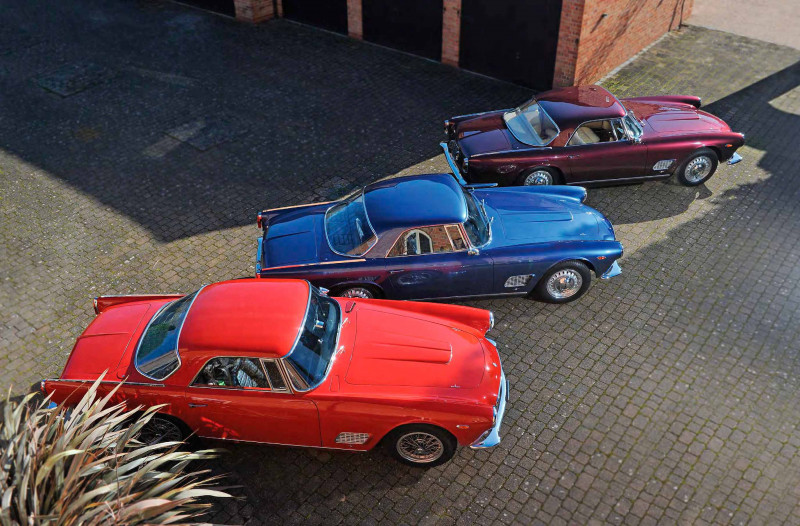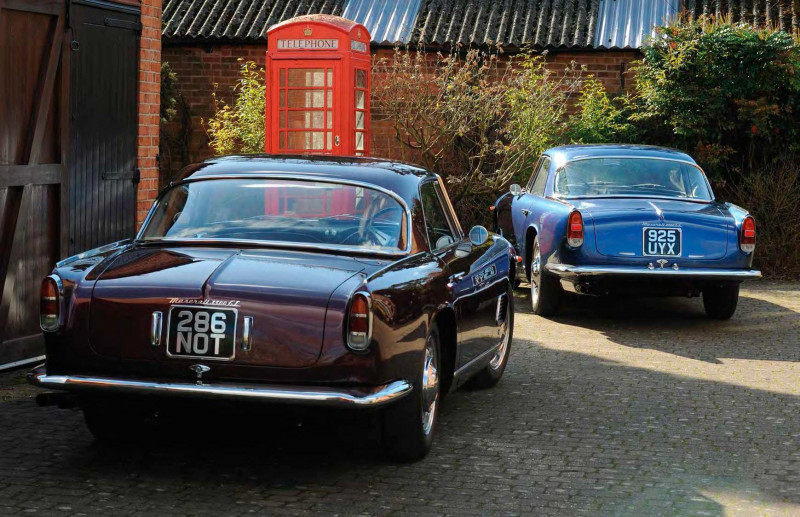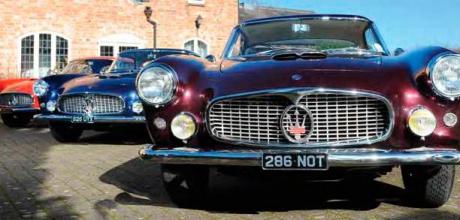Maserati 3500 GT triple test - Early Maserati heaven – times three!
Maserati’s first ever road car, the 3500 GT was hugely appreciated as a grand tourer in its day, before suffering neglect as a classic. Its reputation is now being restored – and so are the cars, as one man’s hat-trick clearly shows. Story by Andy Heywood. Images by Michael Ward.
Dramatic landmarks have always punctuated the turbulent history of Maserati, from that moment in 1926 when the Maserati brothers progressed from modifying the work of others to building their first car, to the recent announcement that the MC20 would use the first Maserati-designed and Maserati-built engine after 20 years of Ferrari influence. These and many other decisions have changed the direction of the company, but even today, over 60 years after its launch, the introduction of the 3500 GT remains the single most significant. At the Geneva Motor Show in March 1957, Maserati the racing car constructor announced to the world that it was henceforth going to be a manufacturer of road cars.

The cultural shift was seismic. As Maserati’s Chief Engineer Giulio Alfieri said later: “Until the 3500 came out, Maserati had never made more than two to three cars a month”. It is difficult to imagine today just how small the Maserati company was at that time. There was no production line; the factory in Modena had just two assembly halls with various racing cars on axle stands being either constructed or repaired. The workforce was small and made up of engineers and mechanics. The bodies were hand-fabricated in even smaller workshops by local artisans such as Fantuzzi. What Maserati did have, however, was an engine manufacturing facility and it was here that the new car began.
“The 3500 GT debuted in 1957, just after Fangio had won the F1 Championship, and just as Maserati closed its racing department to concentrate on building the road car ”

Adolfo and Omer Orsi, the owners of Maserati, knew that they didn’t want a V12 engine as this configuration was already synonymous with their closest competitor, Ferrari. And while they had experience with numerous other permutations, they eventually settled on an in-line six-cylinder unit. The new car had to have a powerful engine but also be capable of being used every day and therefore the simpler approach was chosen for reliability and ease of maintenance. That the result was visually very similar to Maserati’s Formula 1 engine must have helped the decision.
With racing engines, the company was used to making changes to engine design on an almost individual basis but there were certain design features that, once proven, would be used again and again such as the ‘house style’ twin cam covers with Maserati script, twin spark plugs per cylinder and a bank of three twin-choke Weber carburettors.
Alfieri had already experimented with different capacities for the in-line six and different states of tune and therefore knew already how to construct the ultimate specification for the new engine. Even the capacity of 3.5 litres was something he had already tested, in the sports racing 350 S. All of this experience allowed him to work quickly, which reduced development costs but also kept Maserati ahead of another competitor, Aston Martin, whose six-cylinder DB4 would arrive a year later.
Maserati showed two completed prototypes on its stand at the 1957 Geneva Show. These were very different cars, as one was bodied by Allemano and the other by Touring of Milan. The Orsis had commissioned a third design by Zagato as well, although it progressed no further than a styling concept. This was an early form of customer clinic, in which Touring was ultimately successful, helped no doubt by the fact that it was also able to offer manufacturing facilities.
While Touring was a long-established coachbuilder, it too had to expand in order to cope with the demand for the new Maserati and other commissions from Lancia and Alfa Romeo. These last years of the 1950s were ones of great industrial optimism and growth in Italy, finally shaking off post-war austerity. Touring moved to larger premises in 1958 and while the production ‘lines’ were not yet automated, they were a lot more advanced than those at Maserati. Touring’s design used its patented Superleggera construction method of lightweight aluminium panels fitted around an inner steel framework. This allowed the long-wheelbase 2+2 Maserati to tip the scales at a very competitive 1300kg.
Maserati’s chassis supplier, Gilco, fabricated the bare chassis, a mixture of oval steel tube and box section sills, which were then bodied, painted and trimmed at Touring before delivery to the Maserati factory in Modena to have the mechanical parts fitted. Further cutting development time and cost, Maserati negotiated the purchase of many other components such as gearboxes from ZF in Germany, axles from Salisbury and front suspension from Alford and Alder in the UK. Alfieri’s genius was to make all of these parts work so well together.
The definitive version of the 3500 GT was presented at the Turin Motor Show in October 1957 ¬– perfect timing as Juan Manuel Fangio had just won the Formula 1 Championship in a Maserati 250 F. With that came the shock news that Maserati was closing its factory competition department to concentrate on building the road car. The reasons given were financial. Suffering a large loss in its machine tool division, as well as attempting to support a works Formula 1 team in pre-sponsorship days, proved too much for the Orsis and the company was on the brink of receivership. As a strategy to add publicity to the launch of the new car, it was certainly high-risk but it paid off.
Production got under way in late 1957 and continued until 1964. In recent times, Maserati Classiche has revised the production figures for the 3500 GT (or AM101 series after Alfieri Maserati). For many years, the number quoted was 1984 but the true figure is actually 1402. This makes more sense to historians who crunch the chassis numbers but regardless, the 3500 series was more successful than any other model until the Merak. Specification changes were made almost continually along the way, but the main improvements came in late 1961 with the advent of the Series 2 or GTI, so called because of its adoption of Lucas mechanical fuel injection.
Maserati’s worldwide fame in racing gave the 3500 GT a head start in a number of markets. The largest number of cars went to the USA, with Italy, France, Switzerland and Germany taking the majority of the rest. Only 43 cars were made in right-hand drive, of which 34 came to the UK. Setting up sales networks and concessionaires was all new to Maserati at that time and while it relied on previous racing contacts in most countries, the little-known Colin Murray Garages of Fleetwood in Lancashire became the first UK concessionaire.
Maserati capitalised on its success with the follow-up Sebring and Mistral. The 3500 GT’s job was done. As was the norm in those pre-classic times, old cars were soon forgotten, becoming cheap runabouts for eccentric enthusiasts and after only a few years, the 3500 descended into the exotic car poverty trap. The high costs and low availability of factory spare parts contributed to this and the expertise required to repair the aluminium Superleggera body led to many damaged or corroded examples being bodged.
By the time the youngest 3500 was only 10 years old, the model had reached its lowest ebb. Even the emergence of the first UK Maserati Club in 1972 only helped to prop up the few cars still running. Incredibly, this situation didn’t really change until the advent of the first classic car boom in the late 1980s. During those few dizzy years, some average cars were hastily restored to cash in on the market but proper restoration took so long that many others were not finished before the market crashed again, and it would be another decade before interest recovered.
Since the beginning of this century, interest in the 3500 GT has risen steadily. What is extraordinary is how many cars are now known to have survived in one form or another. In the pre-internet era, it would have been assumed probably no more than 10% were left but currently the whereabouts of over 50% are known and still counting. However, the decades in the wilderness have taken their toll and the majority of cars are in very poor condition, many having been left to rot or partially dismantled in the honeymoon period of well-intentioned restorations. It does seem that compared to many other classic cars, the number of 3500 GTs in pieces is high, but the good news is that no matter how bad they are, something has made all of these owners keep them. Their dreams are still alive.
That dream started for Keith Hudson, the owner of our featured cars, many years ago, with a pin up of a 3500 GT on his garage wall. He’d always admired the styling, although never thought he would ever be in a position to own one. In 2015, having retired from the printing industry and able to spend more time on his passion for car restoration, he had that ‘now or never’ moment and placed a wanted ad on a classic car website. One seller responded but what he offered to Keith must have made him initially question his sanity, though he bought it anyway. The car was a 1960 3500 GT that had been delivered new in the USA. At some time, it had suffered engine trouble so the original unit had been replaced with a Ford engine. Luckily the original engine was kept with it. The whole thing had been sold to Sweden in the mid-1980s by which time it had been dismantled for a restoration that was started and aborted on more than occasion. When it arrived at his Leicestershire home, it was little more than a kit of parts. Even the body had been dismantled, with the aluminium skins now only loosely draped over the frame below.
Although Keith is not a professional restorer, he has amassed a huge amount of experience, for instance winning concours events with his collection of Jensens. He could see, through the carnage, that the basics of this car were good and undeterred he embarked on a four-year restoration. Using a local company called Faircharm Restorations to carry out the major body works enabled Keith to progress the project more quickly. Much of the chassis structure was sound, apart from the box section steel sills, which were remade, together with the boot floor and parts of the bulkhead. The aluminium was re-edged throughout to eradicate the corrosion caused by electrolytic reaction between the steel frame and the aluminium skin and only after many hundreds of hours’ work was the body ready to paint in the stunning cobalt blue you see today.
Back in Keith’s home workshop, the mechanical parts were treated to a similarly thorough overhaul, including the twin-cam engine with the correct Weber carburettors for this Series 1 car. Fully rechromed and retrimmed, the finished car was shaken down prior to its first show, which happened to be the Maserati Club UK annual concours at Blenheim Palace in 2018, where the car won the overall first prize. Equally pleasing to Keith was the recognition it received while on display at the NEC Classic Car Show in November that year, winning runner-up in the Pride of Ownership award. For Keith, though, the greatest recognition came from the Jaguar designer Ian Callum, who posted a photo on Instagram describing it as his favourite car of the show and “so beautiful in so many ways”.
Observant readers will have noticed that there are three 3500 GTs in our photos. During the restoration of the blue car, Keith decided to buy another example – initially because he needed a car to use as a pattern for various parts and the shape of the body on the restoration project. This second example in bright red was in very original condition and therefore only required some light repairs, although Keith couldn’t resist improving the paintwork. Only a few months later, Keith spotted a right-hand drive car at auction and knowing how rare this was, he could not resist and therefore a third example joined the fleet. The RHD car has a long ownership history in the UK, but its condition had also deteriorated, which made it another perfect candidate for the Hudson treatment. Keith admits it is unusual to own three, but even though they are all Series 1 cars, they have different characters and he enjoys driving each of them.
Thankfully, for Keith Hudson and other dedicated owners, the dream has become reality and more and more 3500 GTs are being restored. It’s been a long time coming, but finally the cars that started the modern Maserati company will be back where the Orsis and Alfieri originally intended – on the road.
Right-hand drive car is exceedingly rare. Like all of Keith’s 3500 GTs, it’s a Series 1 example
This stunningly restored cobalt blue 3500 GT won the Maserati UK club concours outright in 2018


